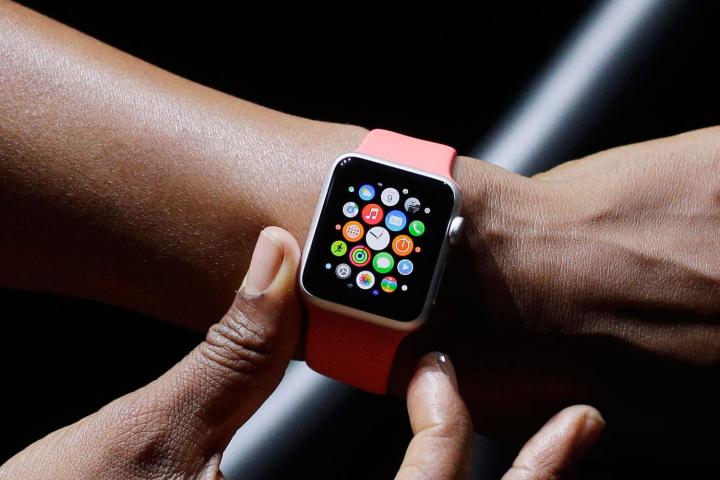
Concerns and skepticism are growing towards the Apple Watch, which experts believe Tim Cook and Co. will reveal Monday, March 9, during a special event in San Francisco. Few people have seen the wearable, and even fewer have actually worn one. When the company unveiled the Apple Watch last September, I was able to wear it but not touch it — an Apple employee pushed the buttons and sent simulated text messages for me. But that hasn’t stopped fanboys and hecklers alike from predicting the imminent downfall of the yet unreleased gadget.
Take the recent Fast Company article, titled “You guys realize the Apple Watch is going to be a flop, right?”
“This feels more like it was designed by committee.”
”Apple may have built out the watch to satisfy the urges of a designer who has become more obsessed with Bentleys and Rolexes than making attractive, functional technology that will actually make life better for the 99 percent,” wrote Mark Wilson, echoing sentiment heard ‘round the Web.
Hell, even Apple doesn’t like the Apple Watch.
Last September after the company’s splashy unveiling event, a former Apple designer who asked not to be named told The New York Times he thought the Watch looked boring.
“It’s very hard to make big things small,” he told The Times. “This feels more like it was designed by committee.”
Technology challenges
After reporting that Apple had dropped many of the intriguing technologies that could have helped the Watch stand out from the crowd, The Wall Street Journal’s Daisuke Wakabayashi reported on the issues the company was likely to face. Executives were left “struggling to define the purpose of the smartwatch and wrestling with why a consumer would need or want such a device.”
CNNMoney’s David Goldman had a similar opinion, explaining that “nearly 70 percent of Apple’s revenue comes from the iPhone, iPad sales are slumping, and Apple needs a new product to reduce its reliance on one core product.”
“It won’t find that with the Apple Watch,” Goldman said.
While the Watch may sell more units than any other smartwatch on the market (which frankly isn’t saying much), it will be hard pressed to transform and legitimatize the space as they company once did with the iPhone and iPad. Heck, even the diehard are reluctant to rush out and pick one up.
In a defensive editorial on MacWorld UK, (titled “Why it doesn’t matter if Apple Watch is a flop — it will still change the world”) the site’s top editor Karen Haslam admitted she had no plans to buy one.
“Right now, I’m just not that sure I really need an Apple Watch. I just can’t see what it can do for me.”
One of the biggest challenges is doing something interesting, and as Wakabayashi reported, the more interesting health and fitness sensors simply aren’t good enough. Apple tested sensors to measure blood pressure, the amount of oxygen in the blood, and conductivity of skin, useful for heart-rate monitoring, people familiar with Apple’s plans told the Journal.
Even the diehard are reluctant to rush out and pick one up.
“But these features didn’t perform consistently on some people, including those with hairy arms or dry skin,” Wakabayashi wrote. I’ve heard the same sentiment echoed from many others in the wearable industry.
Battery life is the other huge challenge facing wearables, and far from solving the issue, Apple seems to be struggling with it — as is the rest of industry, of course. The company has said nothing about battery life to date, but predictions cite numbers as low as 3 hours of active use. Those figures come from Mark Gurman at 9to5Mac.com, and have been widely reported.
The well-respected John Gruber of Daring Fireball characterized the math to get to those numbers as “willfully obtuse,” yet admitted that this area remains a tough nut. “Battery life may well be a serious problem for Apple Watch. It’s no surprise that it was and will remain one of the hardest engineering problems on the project,” he wrote.
Where does this leave Apple?
The Apple Watch we will soon have is “pedestrian,” according to the Wall Street Journal. Ouch.
But that’s for a real reason: The challenge, the experts note, is that the Apple Watch looks astonishingly like every other smartwatch on the planet, products that have been out for years ahead of Apple. That was certainly my take on it, after wearing an Apple Watch briefly after the September event.
Frankly, the innovative work in the world of technology is going on elsewhere, noted a recent editorial on Engadget.
“Its latest project, the Apple Watch, sure looks like a smartwatch, and it might be very successful, but is it doing anything totally unique? Is it really exciting? No,” wrote senior editor Aaron Souppouris in a column titled “When did Apple become the boring one?”
Peter Cohan, a financial analyst with Forbes, wrote an article last month noting that Wall Street has dramatically scaled back expectations for the Apple Watch. The solution, he claims, is innovation. And the company hasn’t been innovating, he states bluntly.
“Apple under Tim Cook has yet to prove that it can innovate.”
And that’s just the problem here. The Apple Watch isn’t a game changer: It looks like the competition and suffers the same flaws as the competition. Ultimately, is that enough to make it a success? Remember that Macworld essay, “Who cares if it’s a flop”?
“The Apple Watch will have to do a lot more than notifications, tell the time, and monitor our fitness if it is to change our lives and justify its [$349] price tag,” wrote Haslam.
Apparently it won’t.
But that’s just the pundits: What do you think? Let us know in the comments section.




